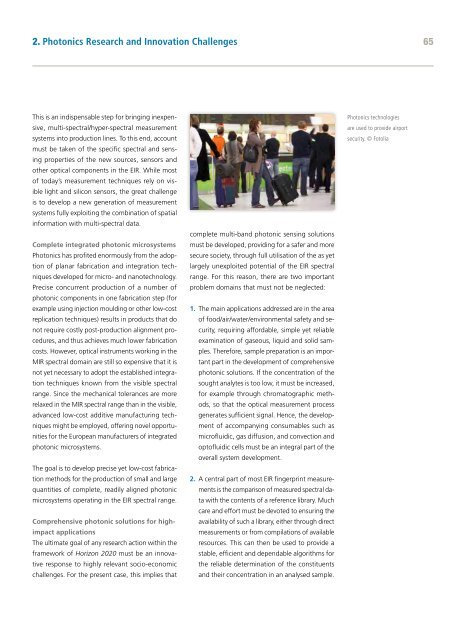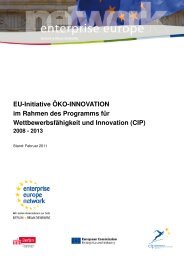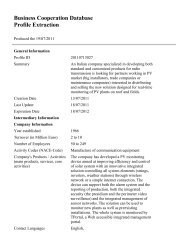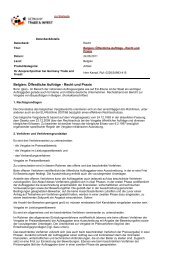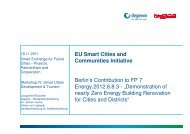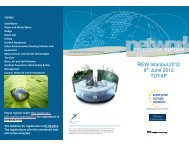Photonics Driving Economic Growth in Europe - Photonics21
Photonics Driving Economic Growth in Europe - Photonics21
Photonics Driving Economic Growth in Europe - Photonics21
You also want an ePaper? Increase the reach of your titles
YUMPU automatically turns print PDFs into web optimized ePapers that Google loves.
2. <strong>Photonics</strong> Research and Innovation Challenges<br />
This is an <strong>in</strong>dispensable step for br<strong>in</strong>g<strong>in</strong>g <strong>in</strong>expen-<br />
sive, multi-spectral/hyper-spectral measurement<br />
systems <strong>in</strong>to production l<strong>in</strong>es. To this end, account<br />
must be taken of the specific spectral and sens-<br />
<strong>in</strong>g properties of the new sources, sensors and<br />
other optical components <strong>in</strong> the EIR. While most<br />
of today’s measurement techniques rely on vis-<br />
ible light and silicon sensors, the great challenge<br />
is to develop a new generation of measurement<br />
systems fully exploit<strong>in</strong>g the comb<strong>in</strong>ation of spatial<br />
<strong>in</strong>formation with multi-spectral data.<br />
Complete <strong>in</strong>tegrated photonic microsystems<br />
<strong>Photonics</strong> has profited enormously from the adop-<br />
tion of planar fabrication and <strong>in</strong>tegration tech-<br />
niques developed for micro- and nanotechnology.<br />
Precise concurrent production of a number of<br />
photo nic components <strong>in</strong> one fabrication step (for<br />
example us<strong>in</strong>g <strong>in</strong>jection mould<strong>in</strong>g or other low-cost<br />
replication techniques) results <strong>in</strong> products that do<br />
not require costly post-production alignment procedures,<br />
and thus achieves much lower fabrication<br />
costs. However, optical <strong>in</strong>struments work<strong>in</strong>g <strong>in</strong> the<br />
MIR spectral doma<strong>in</strong> are still so expensive that it is<br />
not yet necessary to adopt the established <strong>in</strong>tegration<br />
techniques known from the visible spectral<br />
range. S<strong>in</strong>ce the mechanical tolerances are more<br />
relaxed <strong>in</strong> the MIR spectral range than <strong>in</strong> the visible,<br />
advanced low-cost additive manufactur<strong>in</strong>g techniques<br />
might be employed, offer<strong>in</strong>g novel opportunities<br />
for the <strong>Europe</strong>an manufacturers of <strong>in</strong>tegrated<br />
photonic microsystems.<br />
The goal is to develop precise yet low-cost fabrication<br />
methods for the production of small and large<br />
quantities of complete, readily aligned photonic<br />
microsystems operat<strong>in</strong>g <strong>in</strong> the EIR spectral range.<br />
Comprehensive photonic solutions for highimpact<br />
applications<br />
The ultimate goal of any research action with<strong>in</strong> the<br />
framework of Horizon 2020 must be an <strong>in</strong>novative<br />
response to highly relevant socio-economic<br />
challenges. For the present case, this implies that<br />
complete multi-band photonic sens<strong>in</strong>g solutions<br />
must be developed, provid<strong>in</strong>g for a safer and more<br />
secure society, through full utilisation of the as yet<br />
largely unexploited potential of the EIR spectral<br />
range. For this reason, there are two important<br />
problem doma<strong>in</strong>s that must not be neglected:<br />
1. The ma<strong>in</strong> applications addressed are <strong>in</strong> the area<br />
of food/air/water/environmental safety and security,<br />
requir<strong>in</strong>g affordable, simple yet reliable<br />
exam<strong>in</strong>ation of gaseous, liquid and solid samples.<br />
Therefore, sample preparation is an important<br />
part <strong>in</strong> the development of comprehensive<br />
photonic solutions. If the concentration of the<br />
sought analytes is too low, it must be <strong>in</strong>creased,<br />
for example through chromatographic methods,<br />
so that the optical measurement process<br />
generates sufficient signal. Hence, the development<br />
of accompany<strong>in</strong>g consumables such as<br />
microfluidic, gas diffusion, and convection and<br />
optofluidic cells must be an <strong>in</strong>tegral part of the<br />
overall system development.<br />
2. A central part of most EIR f<strong>in</strong>gerpr<strong>in</strong>t measurements<br />
is the comparison of measured spectral data<br />
with the contents of a reference library. Much<br />
care and effort must be devoted to ensur<strong>in</strong>g the<br />
availability of such a library, either through direct<br />
measurements or from compilations of available<br />
resources. This can then be used to provide a<br />
stable, efficient and dependable algorithms for<br />
the reliable determ<strong>in</strong>ation of the constituents<br />
and their concentration <strong>in</strong> an analysed sample.<br />
<strong>Photonics</strong> technologies<br />
are used to provide airport<br />
security. © Fotolia<br />
65


